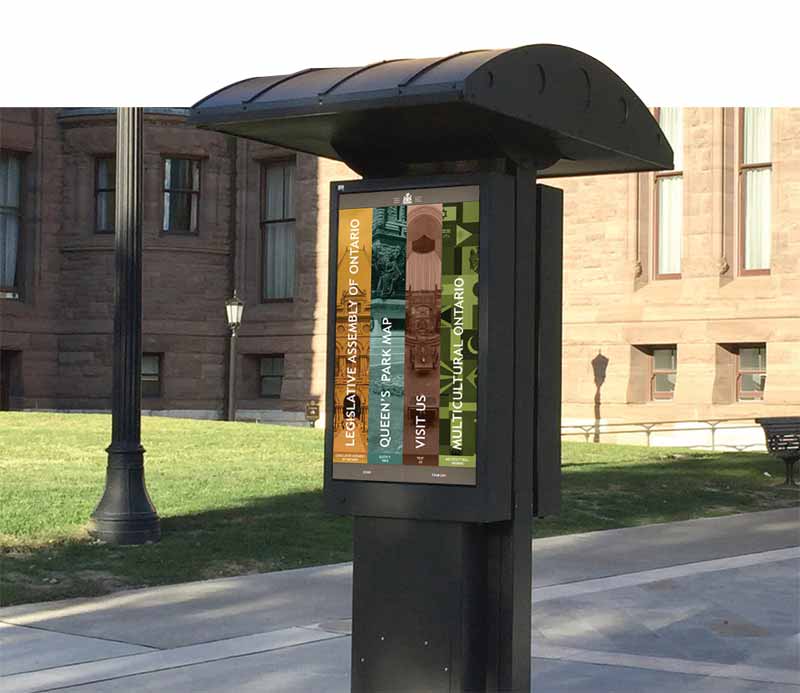How to launch a network
by | 5 October 2018 11:10 am
By Steve Kaelble
 [1]
[1]Dot2Dot Communications applied Scala-based digital signage technologies to craft a complete turnkey signage system for PCL’s new Toronto district office. The digital signage was built to enhance the company’s internal communications, brand recognition, and employee appreciation.
Signs sure are not what they used to be. People have been creating signs since the days of drawings on cave walls and, for many, many generations, this medium of information-sharing did not change much. The messages on signs throughout most of human history have been permanent, fixed, and static.
What is possible today through digital signage is vastly different, incredibly useful, and much more powerful. Just as a smartphone can do much more than a telephone could, so too has digital signage represented a giant leap forward in technology.
Finding purpose
There are many purposes digital signage can serve. Before planning and implementing a new network, it is important to define what goals it will accomplish and what benefits it will provide for the client.
Generating revenue
Revenue generation is often a key driver for a digital signage project. The most obvious way to make money in this context is by selling digital out-of-home (DOOH) advertising. There are many businesses today that pay to get their messages across using digital signage to target the audience in a certain area.
Another related objective is to drive sales. On-premise digital signage is frequently used to encourage customers to buy certain products and services. Examples include banks using screens to cross-sell insurance coverage to customers while they wait in line to see a teller. Many quick-service restaurants (QSRs), meanwhile, use digital signage to upsell special meal combos.
Saving money
Digital signage can also save a lot of money that would otherwise be spent on the printing, shipping, installation, and periodic changing out of wide-format graphics. Such activities can run up big bills for organizations in terms of materials, logistics, and labour. For many of them, this reason alone is enough to transition them toward digital signage.
Engaging an audience
There are also situations where the point of digital signage is not to make or save money, but to convey important information to a certain audience e.g. employees, or the general public. Digital signage can entertain, distract, and assist its audience, whether to improve morale or to guide visitors through a facility.
Understanding the environment
 [2]
[2]Custom-crafted employee award displays were designed to provide an attractive esthetic to communicate PCL award recipients.
Another step in the planning phase is determining where displays will be installed. Just as with real estate, ‘location, location, location’ is very important.
There may be multiple displays within a single facility and/or installations across multiple locations. Some retailers, for example, have installed digital signage everywhere from their entranceway to their checkout.
These decisions are also related to the types of displays. Liquid crystal displays (LCDs) are available in many sizes, from digital photo frames up to multi-panel video walls. And while a menu board may need to be brightly visible from behind a busy counter, a wayfinding kiosk with a touchscreen will need to be comfortable to look at and use from up close.
Fortunately, content management system (CMS) software can pull together multiple types of screens into the same network. It can also support the future growth of a scalable digital signage network, whereby more screens and locations are added over time.
Speaking of touchscreens, the planning phase is also the time to consider how the network will interact with its audience. In some locations, the audience will just be spectators, but in others, an interface can allow them to become participants, whether via touch, smartphone, loyalty program card, or other method.
Increasingly, organizations are seeking metrics to show how many people are viewing their displays, for how long, etc. This desire will influence installation location decisions and can be supported with technology that measures gaze duration and uses facial recognition to guess each viewer’s age and gender. In turn, content can be arranged to respond to viewer-based triggers, such that an ad for a toy appears on a screen when a child approaches, by way of example.
It is also important to work with the organization’s information technology (IT) department. For one thing, members of that department may have experience with digital signage platforms and systems. For another, they will understand what might work best in the context of the organization. And finally, they can ensure the ‘backbone’ of the network is adequately supported on an ongoing basis.
Picking partners
 [3]
[3]This complete turnkey signage system included a multi-lingual interface, audio connectivity, and wheelchair accessibility to promote inclusivity in the community.
Digital signage systems should not be a technological burden for those implementing and managing them. Today, they can be fairly easy to use, even when it comes to creating content for them.
The key is to find, choose, and connect with the right team of partners. These will include suppliers of hardware and software platforms. Some may be certified for specific brands and systems, having built up relevant expertise over the years. Technology partners can also help add value through customization and a variety of ‘bells and whistles.’
With this in mind, the best partners see each other as more than just vendors and customers. Instead, they work together as a team with shared interests, trust, and honesty. Together, they find ways to save money, adapt existing content, and optimize the overall workflow.
Installation, too, may involve collaboration between partners, particularly the IT department.
Ensuring a successful implementation
A new rollout is always exciting, but it is important to be patient and follow certain steps to ensure a successful digital signage installation.
There may be some final decision-making, for example, involving precisely where the displays will be hung or otherwise placed. This may be based on where a panel will be most effective at capturing attention, supporting interactivity, integrating with the surrounding environment, and not causing traffic issues. Locations may even dictate whether the network uses software that resides within the hardware or, instead, Software as a Service (SaaS) via the cloud.
There is certainly a lot more to implementation than installing the screens and flipping a switch. Creation of the initial content is of major importance and, depending on the particular system and goals, can be a significant task unto itself.
In some cases, content creators write new copy and produce original videos to appear on the displays. DOOH advertising may be solicited from outside the organization, but it might also need to be customized for the network before it is displayed. In any case, content will need to be loaded into the system and scheduled appropriately.
There may also be related process that affect or are affected by the digital signage content. If a retailer is planning to advertise certain items that are on sale, it is important to ensure those products are already on the racks or shelves in sufficient quantities, with the right prices marked. And if content will be based on other sources of data, such as a customer loyalty program, then it is essential to create and test links between the two to ensure their combined functionality.
 [4]
[4]Flexibility and overall simplicity of digital signage software is a key differentiator for PharmaChoice. Pharmacy owners have a special need to educate and inform their customers.
Digital signage content is not unlike the Internet, in that it needs to be refreshed or changed frequently to keep people’s attention. So, there should be processes in place for updating content on a regular basis.
Supporting the screens
After a new digital signage network is up and running and looking good, there needs to be continuous support to keep it running properly. Beyond maintenance, such support could involve updates, in-person consulting and training opportunities.
As mentioned earlier, metrics can help measure the impact and results of a digital signage project. The issues this notion raises include which metrics to establish, how frequently to gather them, how best to compile them, and how to present consequent findings. The process may be handled in-house or by outside partners.
The next, related process, of course, is how to follow up on these metrics and observations with actions to make the digital signage network even more effective. For this purpose, regular followups should be scheduled to identify what works well and what could be improved.
A digital signage network is easier than ever to launch and can do amazing things for an organization, but it is important both to get off to a good start and to continue down the path to success with a focus on shared goals.
Steve Kaelble is an author writing on behalf of Scala, which develops digital signage software that is provided in Canada through various channel partners. For more information, visit www.scala.com[5].
- [Image]: https://www.signmedia.ca/wp-content/uploads/2018/10/IMG_1057.jpg
- [Image]: https://www.signmedia.ca/wp-content/uploads/2018/10/pcl-image-02.jpg
- [Image]: https://www.signmedia.ca/wp-content/uploads/2018/10/oal-image-01.jpg
- [Image]: https://www.signmedia.ca/wp-content/uploads/2018/10/crop_pc-image-02.jpg
- www.scala.com: http://www.scala.com
Source URL: https://www.signmedia.ca/how-to-launch-a-network/